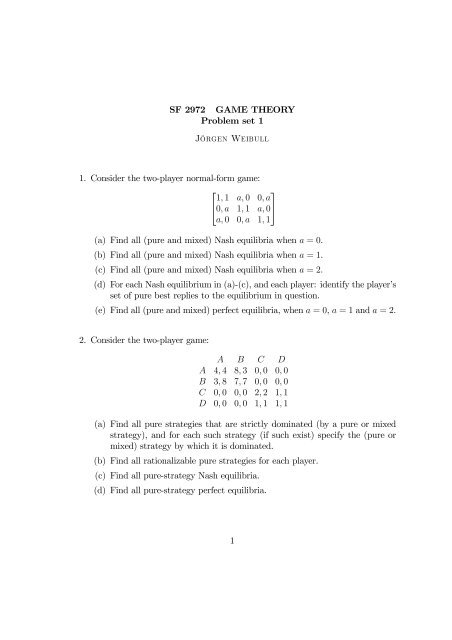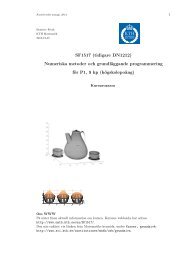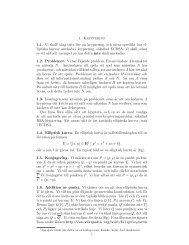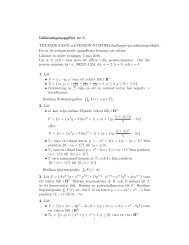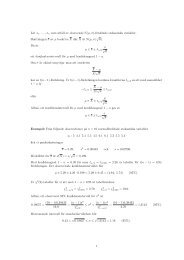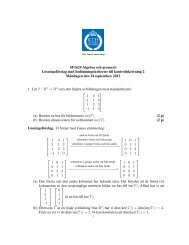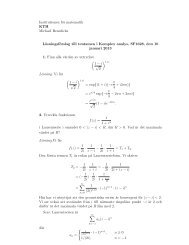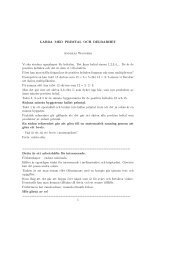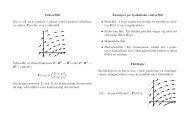SF 2972 GAME THEORY Problem set 1 Jörgen Weibull 1. Consider ...
SF 2972 GAME THEORY Problem set 1 Jörgen Weibull 1. Consider ...
SF 2972 GAME THEORY Problem set 1 Jörgen Weibull 1. Consider ...
Create successful ePaper yourself
Turn your PDF publications into a flip-book with our unique Google optimized e-Paper software.
<strong>SF</strong> <strong>2972</strong> <strong>GAME</strong> <strong>THEORY</strong><br />
<strong>Problem</strong> <strong>set</strong> 1<br />
<strong>Jörgen</strong> <strong>Weibull</strong><br />
<strong>1.</strong> <strong>Consider</strong> the two-player normal-form game:<br />
⎡<br />
⎤<br />
1, 1 a, 0 0,a<br />
⎣0,a 1, 1 a, 0⎦<br />
a, 0 0,a 1, 1<br />
(a) Find all (pure and mixed) Nash equilibria when a =0.<br />
(b) Find all (pure and mixed) Nash equilibria when a =<strong>1.</strong><br />
(c) Find all (pure and mixed) Nash equilibria when a =2.<br />
(d) For each Nash equilibrium in (a)-(c), and each player: identify the player’s<br />
<strong>set</strong> of pure best replies to the equilibrium in question.<br />
(e) Find all (pure and mixed) perfect equilibria, when a =0, a =1and a =2.<br />
2. <strong>Consider</strong> the two-player game:<br />
A B C D<br />
A 4, 4 8, 3 0, 0 0, 0<br />
B 3, 8 7, 7 0, 0 0, 0<br />
C 0, 0 0, 0 2, 2 1, 1<br />
D 0, 0 0, 0 1, 1 1, 1<br />
(a) Find all pure strategies that are strictly dominated (by a pure or mixed<br />
strategy), and for each such strategy (if such exist) specify the (pure or<br />
mixed) strategy by which it is dominated.<br />
(b) Find all rationalizable pure strategies for each player.<br />
(c) Find all pure-strategy Nash equilibria.<br />
(d) Find all pure-strategy perfect equilibria.<br />
1
<strong>SF</strong> <strong>2972</strong> <strong>GAME</strong> <strong>THEORY</strong> <strong>Problem</strong> <strong>set</strong> 1 2<br />
3. <strong>Consider</strong> the two-player normal-form game:<br />
L R<br />
T 7, 6 0, 5<br />
B 2, 0 4, 3<br />
(a) Find all Nash equilibria, perfect equilibria, and proper equilibria (in pure<br />
and mixed strategies).<br />
(b) Suppose that the players can talk with each other before they play. If<br />
you are player 1 (the row player) and player 2 (the column player) says<br />
“Let us play (T,L), it gives us the highest possible payoffs!”, would that<br />
increase the likelihood that you will play T ? If both players care only<br />
about their own payoffs (as given in the payoff bi-matrix), and not about<br />
honesty in communication and other values, does 2’s message then contain<br />
any information about his intention?<br />
4. <strong>Consider</strong> two firms in price competition in a market for a homogeneous good.<br />
The firms simultaneously <strong>set</strong> their prices, p 1 and p 2 , from some given <strong>set</strong> P ⊆<br />
R + . All customers buy from the firm with the lowest price. If both firms <strong>set</strong><br />
the same price, then each firm receives half of the market demand at that price.<br />
Both firms produce at a constant unit cost, c 1 and c 2 ,respectively,andhaveno<br />
fixed costs. Let market demand be D (p) ≡ a − p for some a>0, and assume<br />
that 0 ≤ c 1 ≤ c 2
<strong>SF</strong> <strong>2972</strong> <strong>GAME</strong> <strong>THEORY</strong> <strong>Problem</strong> <strong>set</strong> 1 3<br />
5. Suppose one individual, Anne, owns an indivisible object. Anne is considering<br />
selling this object to a prospective buyer, Bert. The object is worth w to Anne<br />
and v to Bert, where v, w ∈ [0, 1]. If the object is sold at a price p, thenAnne’s<br />
utility is p − w; she has to give up the object worth w to her but receives<br />
p in return. Similarly, Bert’s utility from such a transaction is v − p. If no<br />
trade occurs, then each party obtains utility zero. Suppose that this is a truly<br />
bilateral situation; none of the parties can trade with a third party.<br />
(a) Verify that Pareto efficiency (that is, that there exists no allocation that is<br />
better for both) requires that the object be sold if wv,<br />
and illustrate this in a diagram for valuation pair (w, v) intheunitsquare.<br />
(b) Nowsuppo<strong>set</strong>hatBertdoesnotknowAnne’svaluation,sow is Anne’s private<br />
information. Similarly, suppose that v is Bert’s private information.<br />
To be more precise, suppose that the two individuals have been randomly<br />
drawn from a population of individuals with different valuations, in such a<br />
way that their “types”, w and v, are statistically independent and identically<br />
distributed random variables. Suppose that the trading mechanism is<br />
that the seller, Anne, makes a take-it-or-leave-it offer to Bert, and suppose<br />
that the population value distribution is uniform over [0, 1]. What price<br />
should Anne then <strong>set</strong> in order to maximize her profit? Should the price<br />
depend on Anne’s own valuation?<br />
(c) Suppose that Anne and Bert have decided to instead use the double auction<br />
format, under the same statistical assumption as in the preceding task. In<br />
this mechanism, both parties simultaneously write down a price and puts<br />
it in a sealed envelope. Then the envelopes are opened and trade takes<br />
place at the average of these two prices if the seller’s ask price is lower<br />
than the buyer’s bid price. Otherwise no trade takes place. Verify that<br />
the following strategy pair constitutes a Nash equilibrium: Anne’s ask<br />
price is p A =2w/3 +1/4, unless her valuation w exceeds 3/4, inwhich<br />
case she asks her true valuation, p A = w. Likewise, Bert’s bid price is<br />
p B =2v/3+1/12, unless his valuation v falls short of 1/4, inwhichcase<br />
he bids his true valuation, p B = v. Show also that trade occurs if and only<br />
if Bert’s valuation, v, exceeds Anne’s valuation, w, by at least 1/4, and<br />
indicate the area of no trade in your diagram in (a).


